Raspberries fight free radicals through seven powerful mechanisms: anthocyanins neutralize harmful molecules by donating electrons from their phenolic groups, ellagitannins deliver 75% of the fruit’s antioxidant capacity while protecting your DNA, phenolic compounds boost your natural defense systems, ferric reducing power strengthens cellular protection, flavonoids support immune function through radical scavenging, ellagic acid provides anti-inflammatory benefits at 180mg daily doses, and diverse phytochemicals create multiple protective pathways that enhance your body’s oxidative stress resistance for extensive cellular health benefits.
Anthocyanins Neutralize Harmful Free Radicals in Your Body
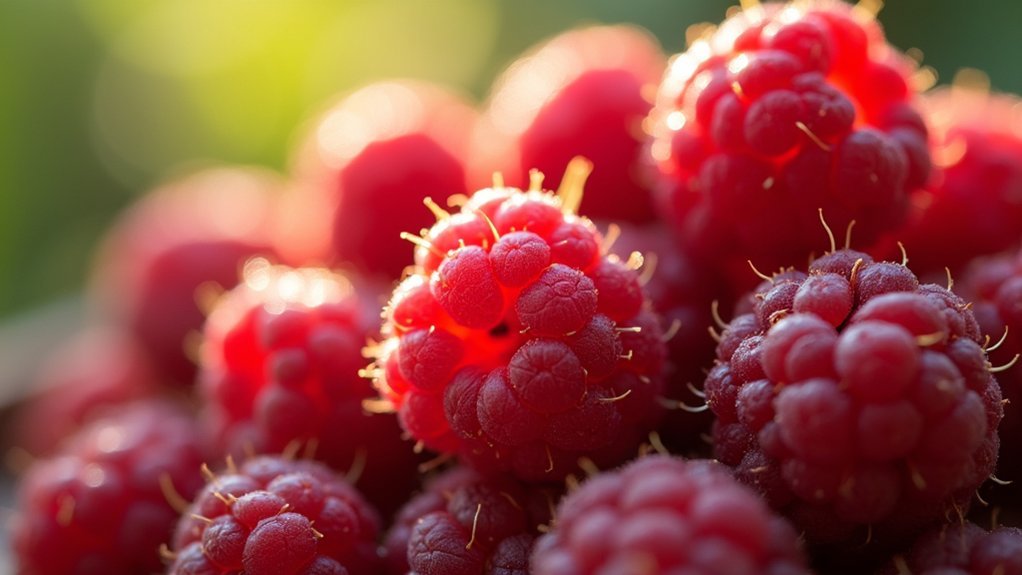
When free radicals attack your cells, anthocyanins—the vibrant pigments that give raspberries their deep red color—step in as powerful defenders.
These compounds contain a flavylium cation structure that’s essential for their antioxidant properties. When you consume raspberries, anthocyanins neutralize free radicals through two key mechanisms: they transfer electrons or donate hydrogen atoms from their phenolic hydroxyl groups.
This process creates semiquinones—more stable compounds that can’t damage your cells. The aglycone form of anthocyanins works most effectively because it delocalizes electrons better than glycosylated versions.
As anthocyanins reduce mitochondrial ROS generation, they prevent oxidative stress from damaging your DNA. They also activate your body’s Nrf2 pathway, enhancing your natural antioxidant defense systems. Many anthocyanin compounds demonstrate superior performance compared to ascorbic acid in antioxidant capacity tests.
Ellagitannins Provide Powerful Cellular Protection Against Oxidative Damage
Your body’s cells face constant attacks from free radicals, but raspberries’ ellagitannins act as powerful defenders that neutralize these harmful molecules before they can cause oxidative damage.
These compounds work through multiple antioxidant pathways, scavenging radicals and protecting your cellular membranes, proteins, and DNA from deterioration. Research shows that ellagitannins demonstrate significant antioxidant activity when protecting human low-density lipoprotein from oxidation.
When you consume raspberries regularly, you’re fundamentally giving your cells a protective shield that reduces oxidative stress and maintains cellular integrity.
Ellagitannin Antioxidant Mechanisms
Although raspberries contain numerous beneficial compounds, ellagitannins stand out as particularly potent cellular defenders against oxidative damage.
These remarkable compounds work through sophisticated mechanisms that you’ll find operate effectively in both lipophilic and hydrophilic environments within your body.
When ellagitannins encounter harmful free radicals, they employ several key strategies:
- Electron donation – They stabilize dangerous free radicals by donating electrons directly.
- Reactive species neutralization – They scavenge oxygen and nitrogen reactive species before cellular damage occurs.
- LDL protection – They shield your low-density lipoproteins from oxidative breakdown.
- Emulsion stabilization – They prevent oxidation in lipid emulsions and food matrices.
The primary ellagitannins in raspberries include sanguiin H-6 and lambertianin C, which together comprise the majority of these protective compounds.
Ellagic acid, a primary derivative, particularly excels at neutralizing these harmful compounds, ensuring your cells remain protected from oxidative stress.
Cellular Defense Properties
Since ellagitannins possess remarkable cellular defense capabilities, they’ll actively shield your cells from multiple forms of oxidative assault throughout your body. These powerful compounds deliver superior antioxidant capacity compared to other raspberry components, creating a robust protective barrier against cellular damage.
| Defense Mechanism | Cellular Impact |
|---|---|
| Oxidative stress reduction | Protects DNA from free radical damage |
| Inflammatory pathway modulation | Blocks harmful NF-κB and MAPK activation |
| Antioxidant enzyme upregulation | Increases NRF2 and heme oxygenase-1 levels |
When you consume raspberries, ellagitannins and their derivative ellagic acid work systematically to neutralize reactive oxygen species before they can harm your cellular structures. Your body’s natural defense systems become strengthened, particularly benefiting from enhanced antioxidant enzyme production that provides long-lasting protection against ongoing oxidative threats. Among the most potent ellagitannins found in red raspberries, sanguiin H-6 demonstrates exceptional cellular protective abilities through its ability to activate beneficial cellular pathways.
Oxidative Stress Reduction
Ellagitannins stand out as raspberry’s most potent weapons against oxidative stress, delivering approximately 75% of the fruit’s total antioxidant capacity when combined with anthocyanins.
These powerful compounds work as free radical scavengers, neutralizing harmful oxidative molecules before they damage your cells.
When you consume raspberries, ellagitannins provide cellular protection through four key mechanisms:
- Direct scavenging – They neutralize free radicals targeting lipids, proteins, and DNA
- Synergistic enhancement – They amplify vitamin C and other polyphenols’ antioxidant effects
- Intracellular protection – They reduce superoxide levels inside your cells
- Metabolic benefits – Their digestive byproducts retain antioxidant activity throughout your body
This multi-layered defense helps maintain your cellular integrity and redox balance during oxidative challenges. By targeting hydroxyl radicals, superoxide radicals, and hydrogen peroxide, ellagitannins address the major reactive oxygen species that contribute to cellular damage and disease progression.
Phenolic Compounds Boost Your Natural Antioxidant Defense Systems
When you bite into a juicy raspberry, you’re consuming powerful phenolic compounds that work as your body’s frontline defense against cellular damage.
These compounds, including anthocyanins and ellagitannins, don’t just act alone—they boost your natural antioxidant systems through synergistic effects with vitamin C and other antioxidants.
Your body synthesizes these phenolic powerhouses through the shikimate and phenylpropanoid pathways, enhancing their radical scavenging activity.
The bioavailability of these compounds determines how effectively they’ll strengthen your antioxidant defenses once absorbed.
Different raspberry varieties offer varying levels of phenolic content, so you’ll get different antioxidant benefits depending on which type you choose.
This enhanced defense system helps reduce oxidative stress and supports your body’s natural ability to combat free radical damage. Additionally, raspberry leaves contain even higher concentrations of these beneficial compounds compared to the berries themselves.
Ferric Reducing Power Strengthens Your Body’s Fight Against Cell Damage
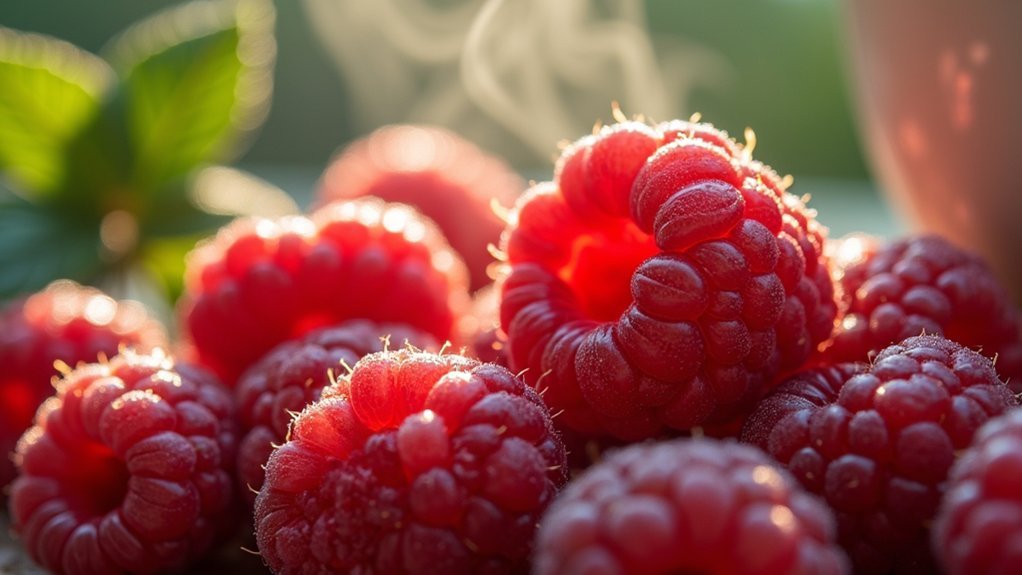
Beyond their impressive phenolic profile, raspberries demonstrate remarkable ferric reducing power that directly strengthens your cellular defenses against oxidative damage.
The FRAP assay measures how effectively raspberry antioxidants reduce iron from ferric to ferrous state, indicating their ability to neutralize harmful free radicals in your body.
Here’s how ferric reducing power protects your cells:
- Electron donation – Raspberry antioxidants donate electrons through redox reactions, neutralizing reactive oxygen species before they damage your cells.
- Time-dependent protection – FRAP activity varies with incubation time, providing both immediate and sustained antioxidant benefits.
- Free radical scavenging – This mechanism directly intercepts free radicals, preventing oxidative stress accumulation.
- Cellular defense enhancement – Strong ferric reducing power translates to better protection against chronic diseases linked to oxidative damage.
The standard 4-minute FRAP measurement significantly underestimates the true antioxidant capacity of raspberries and other berry fruits.
Flavonoids Support Immune Function Through Free Radical Scavenging
When you consume raspberries, their flavonoids actively hunt down and neutralize free radicals that would otherwise damage your cells.
This powerful scavenging action doesn’t just protect individual cells – it strengthens your entire immune system’s ability to defend against threats.
You’re fundamentally giving your body’s natural defenses a significant boost every time you enjoy these antioxidant-rich berries. These berries contain essential dietary fiber ranging from 6.1–7.4g per 100g, which further supports your body’s overall health and immune function.
Flavonoids Neutralize Harmful Radicals
Among raspberries’ most powerful defense mechanisms against cellular damage are flavonoids—specialized compounds that actively hunt down and neutralize free radicals before they can harm your body.
These antioxidant warriors possess unique structural features that make them incredibly effective at protecting your cells.
Here’s how flavonoids in raspberries neutralize harmful radicals:
- Hydrogen atom transfer – They donate hydrogen atoms directly to free radicals, stabilizing these dangerous molecules.
- Electron donation – The 3′,4′-dihydroxy groups in their B ring structure provide electrons that neutralize oxidative threats.
- Metal ion chelation – They bind to metal ions that could otherwise generate more free radicals.
- Enhanced delocalization – Their C2-C3 double bonds conjugated with 4-keto groups maximize radical scavenging capacity.
This multi-pronged approach makes raspberry flavonoids exceptionally potent antioxidants. The antioxidant strength of flavonoids depends on their structural properties, which determines their effectiveness against different types of free radicals.
Enhanced Immune System Protection
Your immune system receives powerful reinforcement when raspberry flavonoids scavenge free radicals that would otherwise compromise immune cell function and trigger harmful inflammatory responses.
These compounds neutralize oxidative stress before it can impair your immune defenses, preventing the overactivation that leads to tissue damage and autoimmune-like reactions.
You’ll benefit from flavonoids’ ability to reduce pro-inflammatory markers like interleukins and cyclooxygenases while maintaining cellular integrity for peak immune performance.
This protection extends beyond immediate immune support—you’re also reducing your risk of chronic diseases linked to immune dysfunction, including heart disease, arthritis, and neurodegenerative disorders. Black raspberries typically contain higher concentrations of these protective compounds compared to their red counterparts.
The high flavonoid content in raspberries works synergistically with other phenolic compounds, strengthening your body’s defense against cellular oxidative damage and supporting long-term immune health.
Ellagic Acid Delivers Anti-Inflammatory Protection at the Cellular Level
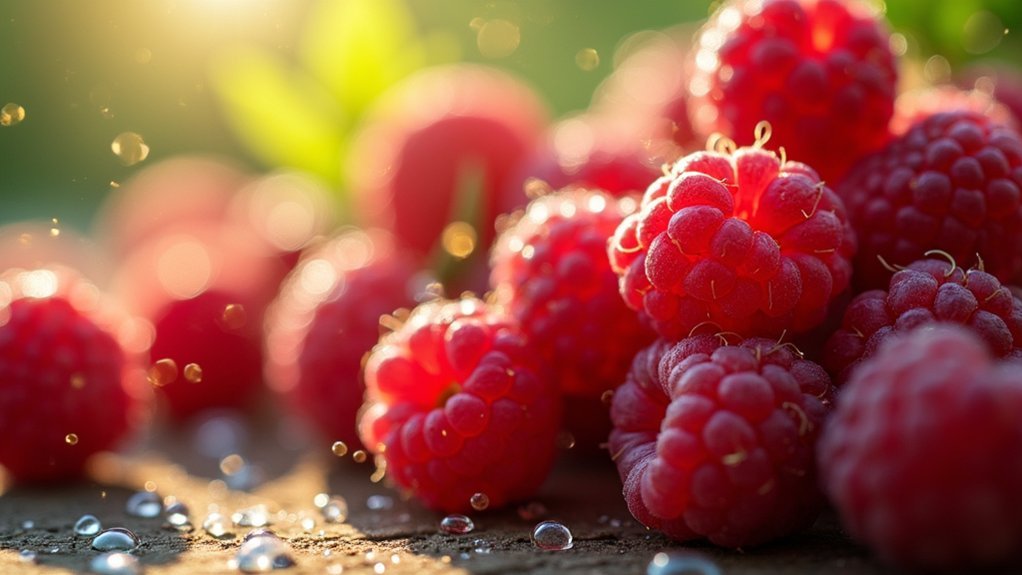
While free radicals wreak havoc throughout your body, ellagic acid in raspberries provides targeted anti-inflammatory protection that works directly at the cellular level. This powerful compound works through multiple mechanisms to control inflammation and protect your cells from damage.
Ellagic acid in raspberries delivers powerful cellular protection by targeting inflammation at its source through multiple protective mechanisms.
Here’s how ellagic acid delivers cellular protection:
- Balances cytokine production – Reduces pro-inflammatory cytokines like IL-17 and IFNγ while increasing anti-inflammatory IL-4
- Suppresses inflammatory enzymes – Inhibits iNOS and COX-2, key players in inflammatory responses
- Modulates gene expression – Suppresses pro-inflammatory transcription factors while enhancing anti-inflammatory gene activity
- Protects neurological function – Reduces blood-brain barrier permeability and TNF-α levels in your central nervous system
Clinical studies demonstrate that up to 180mg daily shows excellent safety while providing measurable anti-inflammatory benefits. Research shows ellagic acid specifically targets MAPK and JAK/STAT pathways to suppress inflammatory signaling in skin cells, making it particularly effective for managing chronic inflammatory conditions.
Phytochemical Diversity Creates Multiple Pathways for Oxidative Stress Reduction
Beyond ellagic acid’s targeted cellular protection, raspberries pack an entire arsenal of phytochemicals that create multiple defense pathways against oxidative stress. You’re getting flavonoids, anthocyanins, and diverse phenolic compounds that each target different oxidative reactions. These compounds don’t just scavenge free radicals—they boost your body’s own antioxidant enzymes like catalase and superoxide dismutase.
| Phytochemical Type | Primary Defense Action |
|---|---|
| Anthocyanins | Inhibit lipid peroxidation |
| Flavonols | Neutralize reactive oxygen species |
| Phenolic acids | Enhance enzyme activity |
| Tannins | Reduce DNA oxidation |
| Proanthocyanidins | Block inflammatory pathways |
This diversity means you’re attacking oxidative stress from multiple angles simultaneously. When combined with other berries, these compounds work synergistically, amplifying their protective effects beyond what isolated extracts can achieve. Research shows that raspberry leaves demonstrate exceptional hydroxyl radical scavenging activity, suggesting that the protective compounds extend throughout the entire plant.
Frequently Asked Questions
Do Different Raspberry Varieties Have Varying Levels of Antioxidant Activity?
Yes, you’ll find significant differences in antioxidant activity between raspberry varieties. For example, ‘Canby’ shows double the antioxidant power of Korean cultivars, while ‘DNS1’ contains the highest total phenolic content.
How Does Raspberry Maturity Affect Their Free Radical Fighting Capacity?
You’ll get the highest antioxidant activity from fully mature raspberries. As they ripen, polyphenols and flavonoids increase markedly, boosting their free radical scavenging power compared to immature or semi-ripe fruits.
Can Environmental Factors Influence the Antioxidant Levels in Raspberries?
Yes, you’ll find that temperature, geography, and seasonal conditions greatly affect raspberry antioxidant levels. Warmer growing conditions can boost antioxidant capacity, while different locations and years create variable phenol and anthocyanin content patterns.
Do Cultivation and Storage Methods Impact Raspberry Antioxidant Retention?
You’ll find that cultivation methods like fertilization practices and genetic variability greatly affect antioxidant levels, while storage techniques including temperature control, vacuum drying, and calcium chloride treatments help you preserve these beneficial compounds effectively.
Which Raspberry Species Shows the Highest Antioxidant Activity Levels?
You’ll find ‘DNS1’, ‘Boyne’, and ‘Beijing10’ varieties show the highest antioxidant activity levels among raspberry species. These cultivars contain elevated phenolic compounds and flavonoids that greatly enhance their free radical-fighting capabilities.
In Summary
You’ve discovered seven powerful ways raspberries combat free radicals in your body. From anthocyanins neutralizing harmful molecules to ellagic acid reducing inflammation, these tiny fruits pack an impressive antioxidant punch. By incorporating raspberries into your diet, you’re giving your cells multiple layers of protection against oxidative damage. Don’t underestimate these small berries – they’re working hard to strengthen your body’s natural defense systems and support your overall health.

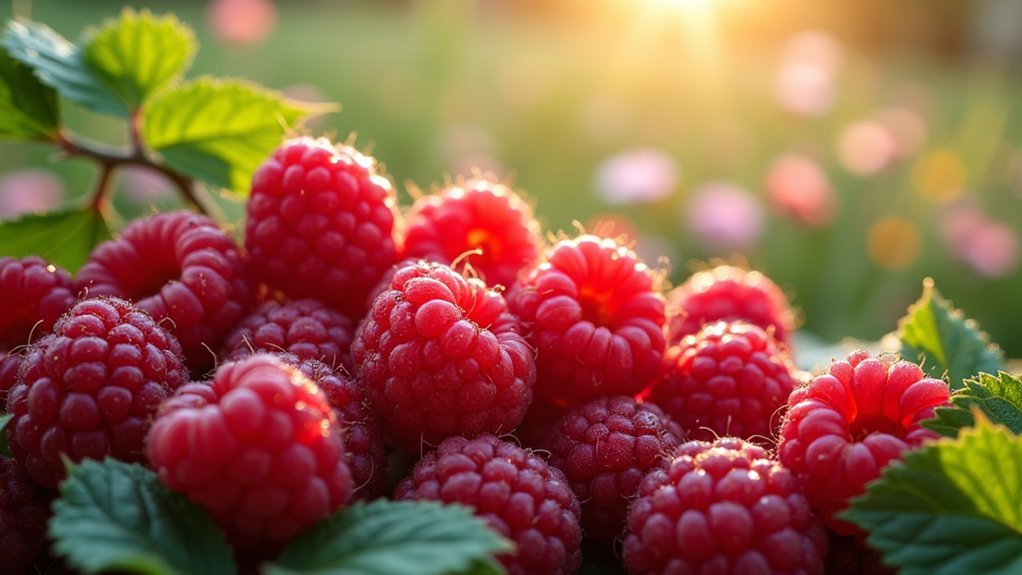
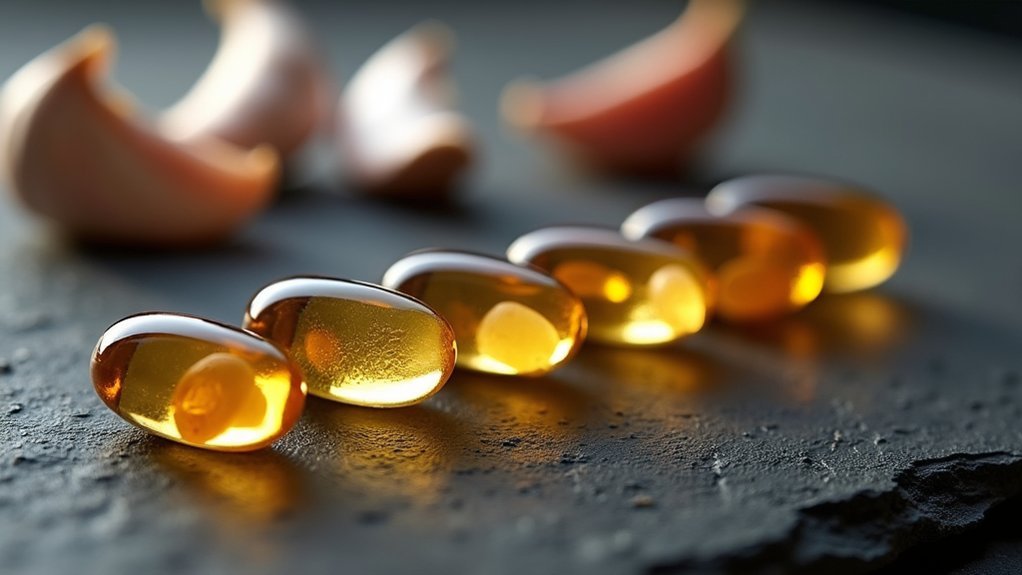


Leave a Reply